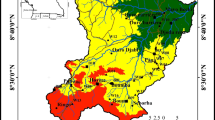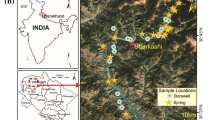Abstract
Concentrations of trace elements in drinking water affect its safety and acceptability for use. Potentially toxic element (PTE) contaminations are considered extremely hazardous because of toxicity, persistence, and bioaccumulative behaviour. Many areas in the Southern African Development Community are data poor and have poor accessibility. The results of our previous research identified the presence of fossil waters in southern Limpopo National Park. Groundwater and river water are the only sources of drinking water for the villages in the study area. The current study focuses on the understanding of trace element distribution and health perspectives of PTEs (Hg, U, Sr, B, and Mn) in the groundwater and surface water samples (rivers and lakes) collected within the buffer zone of the Limpopo National Park, Southern Mozambique. Two sampling campaigns (October 2016–March 2017) were carried out during the end of the wet season and the end of the dry season to analyse the differences. The results improved our knowledge of the occurrence of trace elements in drinking water in an area where water resources play a fundamental role—because of their scarcity—and where the climate is harsh. ICP-MS results provided information on concentration ranges, highlighting the exceedance of the permissible maximum limit of mercury imposed by the World Health Organization on several groundwater samples. In the buffer zone of Limpopo Park, the highest levels of risk seem to be associated with the presence of Hg and U in drinking water. The use of risk assessment markers such as non-cancer risk value (hazard quotient [HQ]) revealed the exceedance of HQ values for Hg and U. The HQ values are higher in the wet season than the dry season, and most of the exceedance has been found in groundwater. HQ values are higher in exposed children than exposed adults. The water of Lake Massingir seems to be safer than any other source, but people do not currently use it because of the distance between the lake and their villages. Proactive control and research on alternative solutions for the water needs of the population and on creation of water distribution are recommended. In the current study, drinking water was the only route of exposure that was evaluated. Therefore, it would be appropriate to investigate the concentrations of PTEs in crops, livestock, and any other potential pathways.
Similar content being viewed by others
References
Acosta, J. A., Jansen, B., Kalbitz, K., Faz, A., & Martínez-Martínez, S. (2011). Salinity increases mobility of heavy metals in soils. Chemosphere, 85(8), 1318–1324.
Africa Groundwater Atlas (2019). Climate. British Geological Survey. [http://earthwise.bgs.ac.uk/index.php/Climate]. Retreived 09 Nov 2019.
Ali, W., Aslam, M. W., Feng, C., Junaid, M., Ali, K., Li, S., et al. (2019). Unraveling prevalence and public health risks of arsenic, uranium and co-occurring trace metals in groundwater along riverine ecosystem in Sindh and Punjab, Pakistan. Environmental Geochemistry and Health, 41(5), 2223–2238. https://doi.org/10.1007/s10653-019-00278-7.
Barbieri, M., Ricolfi, L., Vitale, S., Muteto, P. V., Nigro, A., & Sappa, G. (2019). Assessment of groundwater quality in the buffer zone of Limpopo National Park, Gaza Province, Southern Mozambique. Environmental Science and Pollution Research, 26(1), 62–77.
Caussy, D., Gochfeld, M., Gurzau, E., Neagu, C., & Ruedel, H. (2003). Lessons from case studies of metals: Investigating exposure, bioavailability, and risk. Ecotoxicology and Environmental Safety, 56, 45–51.
Direcão Nacional de Areas de Conservacão (2003) Limpopo National Park Management and Development Plan, (Maputo, Ministry of Tourism, 2003).
DNA (2006). Direcção Nacional de Águas. Estratégia nacional de gestão de recursos hídricos.
FAO-SAFR (2004) Drought impact mitigation and prevention in the Limpopo River Basin: A situation analysis. Sub-Regional Office for Southern Africa/Harare. Rome.
GLTP. Great Limpopo Transfrontier Park. About GLTP. [http://www.greatlimpopo.org/about-gltp/]. Retreived 15 April 2019.
Islam, M. A., Romic´, D., Akber, M. A., & Romic´, M. (2018). Trace metals accumulation in soil irrigated with polluted water and assessment of human health risk from vegetable consumption in Bangladesh. Environmental Geochemistry and Health, 40, 59–85.
IWMI/ARC (2003) Limpopo Basin Profile. CGIAR Challenge program on water and food. Pretoria.
Lehto, T., & Goncalves, R. (2008). Mineral resources potential in Mozambique. Geological Survey of Finland Special Paper, 48, 307–321.
Limpopo Groundwater Resource Information Project (GRIP) (GRIP LIMPOPO) (2002). An initiative of the Department of Water Affairs (DWA) to collate groundwater information and establish a ground-water information system for the Limpopo Province. Online v.2.0. [http://griplimpopo.co.za/]. Retreived 15 April 2019.
Ministerio do Turismo. (2003). Limpopo National Park: Management and Development Plan. Maputo: Ministério do turismo.
Moharir, A., Ramteke, D. S., Moghe, C. A., Wate, S. R., & Sarin, R. (2002). Surface and groundwater quality assessment in Bina region. Indian Journal of Environmental Protection, 22(9), 961–969.
Muchuweti, M., Birkett, J., Chinyanga, E., Zvauya, R., Scrimshaw, M. D., & Lester, J. (2006). Heavy metal content of vegetables irrigated with mixtures of wastewater and sewage sludge in Zimbabwe: Implications for human health. Agriculture, Ecosystems & Environment, 112, 41–48.
Paalman, M. A. A., van der Weijden, C. H., & Loch, J. P. G. (1994). Sorption of cadmium on suspended matter under estuarine conditions: competition and complexation with major seawater ions. Water, Air, and Soil Pollution, 73, 49–60.
Panagos, P., Van Liedekerke, M., Jones, A., & Montanarella, L. (2012). European soil data centre: Response to European policy support and public data requirements. Land Use Policy, 29(2), 329–338.
Pavelic, P., Giordano, M., Keraita, B. N., Ramesh, V., & Rao, T. (2012). Groundwater availability and use in Sub-Saharan Africa: a review of 15 countries. International Water Management Institute (IWMI).
Peace Parks Foundation. (2001). Great Limpopo (map). Peace Parks Foundation, Stellenbosch, South Africa. [https://www.peaceparks.org/tfcas/great-limpopo/].
RWSN (2015). Strengthening the Domestic Drilling Industry Lessons from the Mozambique Drillers Association. RWSN Water and Sanitation Programme.
Tchamo, M. E., Santos, M. A. D. M. D., Almeida, M. B. D., & Leandro, C. G. (2016). Physical fitness and Birth Weight in young men from Maputo City, Mozambique. Revista Brasileira de Medicina do Esporte, 22(1), 66–70.
UNEP, WHO (1996). Water Quality Monitoring.
U.S. Department of Energy (2019). RAIS: Risk Assessment Information System, https://rais.ornl.gov/index.html.
USEPA. (1986). Guidelines for the health risk assessment of chemical mixtures. Federal Register, 51, 34014–34025.
USEPA (1989). Risk assessment guidance for superfund. Volume I: Human health evaluation manual (Part A). EPA/540/1-89/002.
Van Wyk, A.W., 2004: Personal communication.
World Health Organization (WHO) (2011). Guidelines for Drinking-water Quality, 4th edition.
World Population Review (2019). [http://worldpopulationreview.com/countries/mozambique-population/]. Retreived 10 Oct 2019.
Author information
Authors and Affiliations
Corresponding author
Additional information
Publisher's Note
Springer Nature remains neutral with regard to jurisdictional claims in published maps and institutional affiliations.
Electronic supplementary material
Below is the link to the electronic supplementary material.
Supplementary File S1
Parameters for water analyses by ICP-MS (X Series II Thermo Fisher Scientific Inc.) (DOCX 13 kb)
Supplementary File S2
Chemical–physical parameters and concentration of trace elements (DOCX 41 kb)
Supplementary File S3
Groundwater correlation matrix in the dry season (DOCX 19 kb)
Supplementary File S4
Correlation ratios in surface waters in the dry season (DOCX 17 kb)
Supplementary File S5
Correlation ratios in surface waters in the wet season (DOCX 17 kb)
Supplementary File S6
The results of health risk assessment of human exposure to trace elements in drinking water from the buffer zone of the Limpopo National Park. (DOCX 25 kb)
Rights and permissions
About this article
Cite this article
Ricolfi, L., Barbieri, M., Muteto, P.V. et al. Potential toxic elements in groundwater and their health risk assessment in drinking water of Limpopo National Park, Gaza Province, Southern Mozambique. Environ Geochem Health 42, 2733–2745 (2020). https://doi.org/10.1007/s10653-019-00507-z
Received:
Accepted:
Published:
Issue Date:
DOI: https://doi.org/10.1007/s10653-019-00507-z











